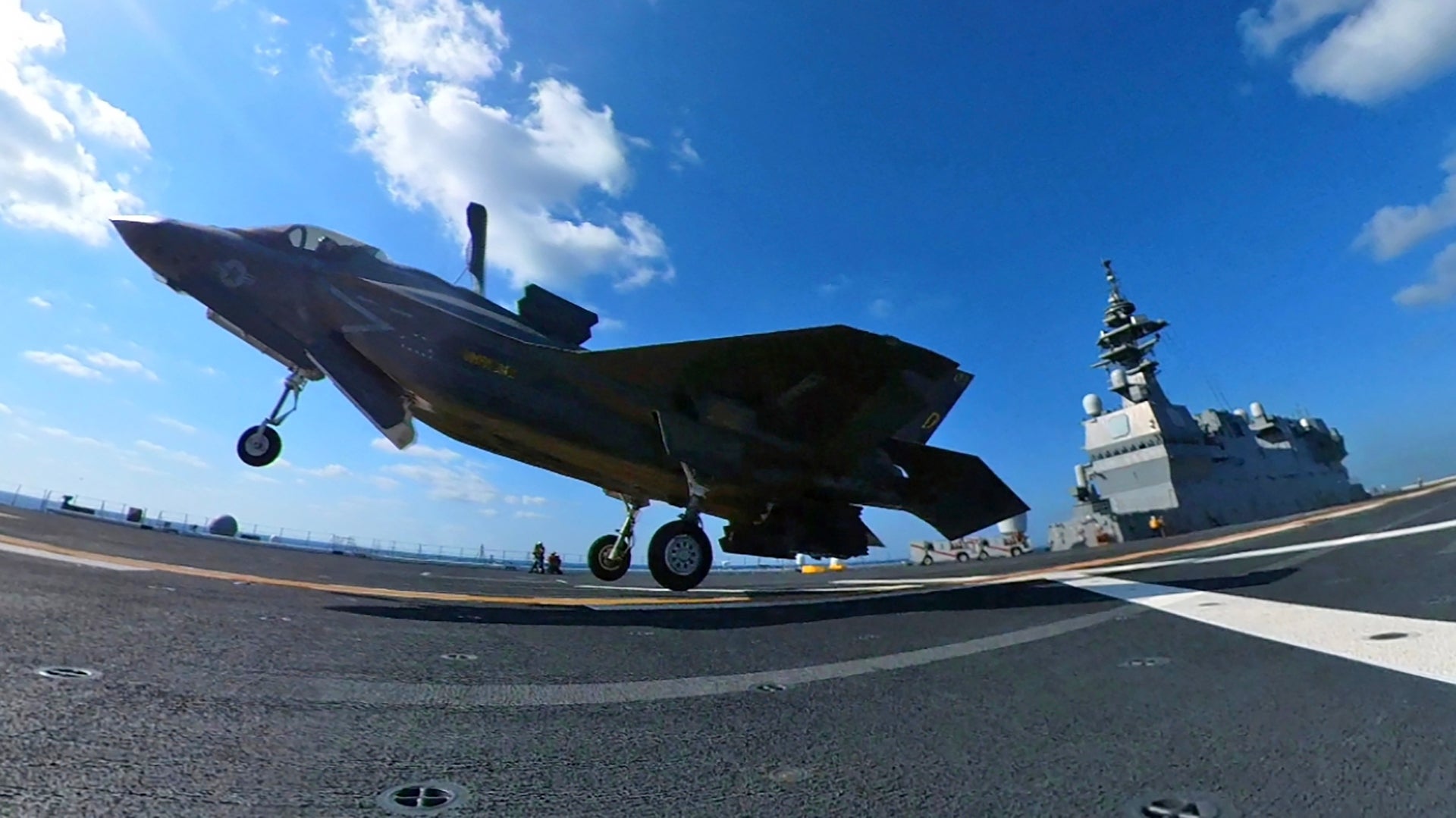Japan is back in the business of operating a fixed-wing aircraft carrier, with the first embarkation of short takeoff and vertical-landing F-35B stealth jets from the U.S. Marine Corps on the modified helicopter carrier Izumo. It is the first instance of the country operating fixed-wing aircraft from ships since the end of World War II. The trials are set to kickstart a new era for the Japan Maritime Self-Defense Force, or JMSDF, which has long harbored ambitions to adapt its two 24,000-ton Izumo class helicopter carriers for fixed-wing operations.
The Japanese Ministry of Defense announced today that the Marine Corps F-35Bs went aboard the Izumo for the first time yesterday, releasing a number of photos and video of the action, which took place in the waters south of Shikoku. Japan’s Ministry of Defense had previously confirmed that Marine Corps F-35Bs would go aboard the Izumo between October 3 and 7, for a period of trials in the Pacific. These will evaluate the modifications that have been made to the Izumo so far, as part of its transition from a very capable helicopter carrier to a true aircraft carrier, able to support and operate fixed-wing short takeoff and vertical-landing (STOVL) types. Ahead of these trials, the Izumo arrived at Iwakuni last week.

You can read all about the preparation for these trials and Japan’s winding road to regaining a fixed-wing carrier capability in this recent The War Zone article.
Check out the F-35Bs in action aboard the Izumo in the video tweet below:
Interestingly, the jets involved wear the markings of Marine Fighter Attack Squadron 242, the “Bats,” which only began their transition to the type at Marine Corps Air Station Iwakuni, Yamaguchi prefecture, in October 2020 and declared initial operational capability (IOC) on the new type last month.
The “Bats” are one of two Marine Corps F-35Bs squadrons at Iwakuni. The other squadron, VMFA-121, the “Green Knights,” had declared IOC back in July 2015, before relocating to the Japanese base in January 2017.
After the concept of fixed-wing operations is proven aboard the Izumo, that warship will then undergo more extensive revisions to better support F-35Bs during routine operations over sustained periods. So far, the vessel has received a heat-resistant flight deck to cope with the F-35B’s scorching exhaust, as well as changes to the lighting and deck markings.

Long term, the warship will need more radical changes to the flight deck, which currently tapers off toward the end, resulting in a trapezoidal shape that reduces the surface area where the jets take off. As we expected, the initial videos of F-35B operations on the Izumo seem to show the jets performing very short takeoffs to address that. Once fully reconfigured, the warship will have a squared-off flight deck, more like that found on the U.S. Navy’s big-deck amphibious assault ships.
When work is completed on the Izumo, it will be the turn of her sister vessel, Kaga, to undergo the same changes, although these are planned to be incorporated in just one period of rework and refit.
Both ships will also receive various changes below the flight deck, making them better able to handle F-35Bs and their maintenance demands, as well as providing storage for ammunition and aviation fuel.
The Izumo after its first set of modifications were completed this summer:
This work is being timed around Japan’s plans to introduce its own F-35Bs in the next few years. Tokyo has announced plans to purchase a total of 147 Joint Strike Fighters, of which 42 will be STOVL F-35Bs, and the remainder conventional takeoff and landing (CTOL) F-35A variants.
Work to adapt the Izumo is scheduled for completion in 2026 and, until then, it’s likely we will see Marine Corps F-35Bs return to the Izumo. These will echo the kinds of trials by the Marine Corps that have also proven vital in introducing the STOVL stealth jet aboard the British Royal Navy’s aircraft carrier HMS Queen Elizabeth and the Italian Navy carrier Cavour.
Japan’s return to operating fixed-wing fighters from its warships has been a long time coming — the last such operations were during the final months of the war in the Pacific in 1945. For most of the years after that, the defensive nature of Japan’s constitution ruled out the possibility of operating a true aircraft carrier. Before long, however, Japan will be capable of launching its own fixed-wing tactical airpower from the sea, which promises to overhaul the capabilities of the JMSDF in the Asia Pacific region, and beyond.
Contact the author: thomas@thedrive.com
